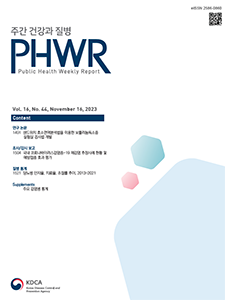Current Issue
Vol.16 No.44, November 16, 2023
-
Original Articles 2023-11-16
 0
0
 299
299
 116
116
Development of a Laboratory Test for Botulism Using Sandwich ELISA
Eun-Sun Choi, So-Hyeon Kim, Jun-Ho Jeon, Hwajung Yi, Yoon-Seok Chung
Public Health Weekly Report 2023; 16(44): 1491-1503 https://doi.org/10.56786/PHWR.2023.16.44.1 Abstract
AbstractBotulism is a flaccid neuroparalytic disease caused by a potent toxin produced by the spore-producing Gram-positive anaerobic bacterium, Clostridium botulinum. Mouse bioassays are a common standard assay for confirmation of botulism, but the assay is causing ethical concerns due to the use of mice and too slow for diagnosis. Therefore, fast and more reliable new detection methods are necessary. This study introduces sandwich ELISA kits for rapid detection of botulinum toxin A or B during bioterrorism or outbreaks. To verify the kits, sensitivity, precision, and specificity tests were conducted using human serum spiked with the toxins. The results showed limit of detections of 0.153 ng/ml and 0.027 ng/ml for toxins A and B, respectively, demonstrating strong repeatability and reproducibility within and between kits and experimenters (coefficient of variation: 10%). Specificity experiments confirmed accurate detection of only A and B toxins, without reacting to other toxins. The study establishes that the botulinum toxin A or B sandwich ELISA kits possess high sensitivity and specificity, effectively detecting toxin of levels comparable to the standard assay. These results suggest that the ELISA would serve as an effective test to detect botulinum toxin in the clinical specimens from the suspected patients. These findings suggest their potential in swift responses to biological terrorism and outbreaks.
-
Surveillance Reports 2023-11-16
 2
2
 323
323
 178
178
The Suspected Coronavirus Disease 2019 Reinfection Cases and Vaccine Effectiveness, The Republic of Korea
Ji Ae Shim, Eunkyung Park, Ryu Kyung Kim, Kil Hun Lee, Myeong Rok Shin, Donghyok Kwon
Public Health Weekly Report 2023; 16(44): 1504-1520 https://doi.org/10.56786/PHWR.2023.16.44.2 Abstract
AbstractAs the coronavirus disease 2019 pandemic continues, the suspected reinfection cases are increasing due to the decrease in immune antibodies and immune avoidance reactions to new variants. We analyzed the characteristics of suspected reinfection cases identified by the surveillance system from January 20, 2020 to July 22, 2023. Moreover, we assessed the vaccination history to evaluate vaccine effectiveness. Among the suspected reinfection cases (7.8%), second infected cases were 98.5%, third infected cases were 1.4%, and more than fourth infected cases were 0.02%. Secondary infections almost were in the Omicron waves, especially with members of long-term care facilities during the Omicron variant period (5.9%) higher than the pre-Omicron period (1.6%). The fatality rate of the second infected cases (0.06%) was lower than the fatality rate of the one-time infected cases (0.12%). The critical infection rate of second infected cases aged 60 or older was 0.54% and the fatality rate was 0.29%. Among second infected cases aged 60 or over, the vaccine effectiveness against critical infection compared to unvaccinated was 68.4% for monovalent vaccine, 77.1% for bivalent vaccine, and the vaccine effectiveness against death compared to unvaccinated was 69.7% for the monovalent vaccine, 81.2% for the bivalent vaccine. Therefore, even in the suspected reinfection cases with the history of previous infection, it is necessary to recommend regular vaccinations to prevent severity and death for the elderly group with a high fatality rate.
-
QuickStats 2023-11-16
 0
0
 122
122
 82
82
Diabetes Awareness, Treatment, and Control, 2013–2021
Public Health Weekly Report 2023; 16(44): 1521-1522 https://doi.org/10.56786/PHWR.2023.16.44.3

pp. 1~2097
Most Keyword
?
What is Most Keyword?
- It is the most frequently used keyword in articles in this journal for the past two years.
Most Read
-
Waterborne and Foodborne Disease Outbreaks in the Republic of Korea, 2023
Myung-Jae Hwang, So Yeon Park, Hyungjun Kim, Se Jeong Yang, Sungchan Yang, Jin Seon Yang
Public Health Weekly Report 2025;18: 17-32 https://doi.org/10.56786/PHWR.2025.18.1.2 -
Implementation Plan for the Coronavirus Disease 2019 Vaccination for the 2024–2025 Season: Recommendations of the 6th Expert Committee on Immunization Practices
Hyewook Hwang, Wookeon Lee, Seohyeon Ahn, Young-Sook Choi, Seunghyun Lewis Kwon, Dongwoo Lee, Eun Hwa Choi, SokGoo Lee
Public Health Weekly Report 2025;18: 90-102 https://doi.org/10.56786/PHWR.2025.18.2.3
Editorial Office
+82-43-719-7569





 Full Text
Full Text Cite
Cite


